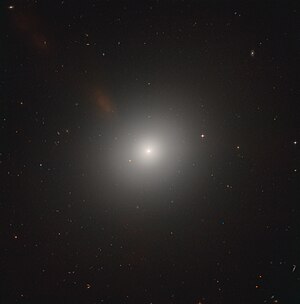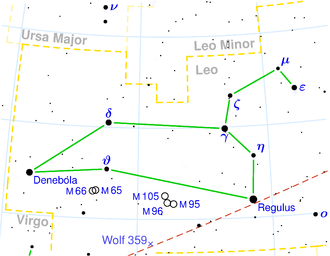Messier 105
| Galaxy Messier 105 |
|
|---|---|

|
|
| Image taken by the Hubble Space Telescope of the elliptical galaxy Messier 105 | |
| AladinLite | |
| Constellation | lion |
|
Position equinox : J2000.0 , epoch : J2000.0 |
|
| Right ascension | 10 h 47 m 49.6 s |
| declination | + 12 ° 34 ′ 54 ″ |
| Appearance | |
| Morphological type | E1 / LINER |
| Brightness (visual) | 9.5 likes |
| Brightness (B-band) | 10.5 mag |
| Angular expansion | 5.3 ′ × 4.8 ′ |
| Position angle | 71 ° |
| Surface brightness | 13.1 mag / arcmin² |
| Physical data | |
| Affiliation | Leo I group LGG 217 |
| Redshift | 0.003039 ± 0.000008 |
| Radial velocity | (911 ± 2) km / s |
|
Stroke distance v rad / H 0 |
(37 ± 3) x 10 6 ly (11.2 ± 0.8) Mpc |
| history | |
| discovery | Pierre Méchain |
| Discovery date | March 24, 1781 |
| Catalog names | |
| M 105 • NGC 3379 • UGC 5902 • PGC 32256 • CGCG 066-018 • MCG + 02-28-011 • 2MASX J10474959 + 1234538 • GC 2203 • H I 17 • h 757 • | |
Messier 105 (also known as NGC 3379 ) is a 9.5 mag bright elliptical galaxy with an area of 5.3 '× 4.8' in the constellation Leo . The galaxy is about 37 million light years from the solar system and belongs to the M96 group .
High-resolution images from the Hubble Space Telescope show a ring-shaped structure around the central black hole that is rotating rapidly. According to calculations, the mass of the black hole is around 200 million solar masses , the galaxy itself has a total mass of 100 billion solar masses.
The elliptical or lenticular galaxy NGC 3384 (= NGC 3371 ) in the immediate vicinity is a physical companion of M105. In contrast, the spiral galaxy NGC 3389 (= NGC 3373 ) , located seven arc minutes southeast of M105, is far in the background.
M105 was discovered on March 24, 1781 by the French astronomer Pierre Méchain . It was only added to the Messier catalog at a later date .
Web links
- M105 at SEDS
- Spektrum.de : Amateur recordings [1]
- Spektrum.de: Map of the area



